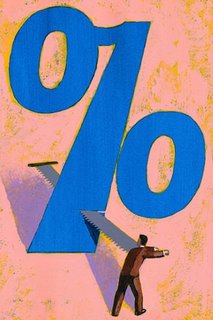U.S. Prime Rate Is Now 4.00%
 The Federal Open Market Committee (FOMC) of the Federal Reserve has just adjourned its seventh scheduled monetary policy meeting of 2008, and, in accordance with the latest forecast, has just lowered its target for the Federal Funds Rate by 50 basis points (0.50 percentage point) to 1.00%. Therefore, as of today, the U.S. Prime Rate is now 4.00%.
The Federal Open Market Committee (FOMC) of the Federal Reserve has just adjourned its seventh scheduled monetary policy meeting of 2008, and, in accordance with the latest forecast, has just lowered its target for the Federal Funds Rate by 50 basis points (0.50 percentage point) to 1.00%. Therefore, as of today, the U.S. Prime Rate is now 4.00%.Here's a clip from a press release issued by the FOMC moments ago:
"...The Federal Open Market Committee decided today to lower its target for the federal funds rate 50 basis points to 1 percent.
The pace of economic activity appears to have slowed markedly, owing importantly to a decline in consumer expenditures. Business equipment spending and industrial production have weakened in recent months, and slowing economic activity in many foreign economies is damping the prospects for U.S. exports. Moreover, the intensification of financial market turmoil is likely to exert additional restraint on spending, partly by further reducing the ability of households and businesses to obtain credit.
In light of the declines in the prices of energy and other commodities and the weaker prospects for economic activity, the Committee expects inflation to moderate in coming quarters to levels consistent with price stability.
Recent policy actions, including today’s rate reduction, coordinated interest rate cuts by central banks, extraordinary liquidity measures, and official steps to strengthen financial systems, should help over time to improve credit conditions and promote a return to moderate economic growth. Nevertheless, downside risks to growth remain. The Committee will monitor economic and financial developments carefully and will act as needed to promote sustainable economic growth and price stability.
Voting for the FOMC monetary policy action were: Ben S. Bernanke, Chairman; Timothy F. Geithner, Vice Chairman; Elizabeth A. Duke; Richard W. Fisher; Donald L. Kohn; Randall S. Kroszner; Sandra Pianalto; Charles I. Plosser; Gary H. Stern; and Kevin M. Warsh.
In a related action, the Board of Governors unanimously approved a 50-basis-point decrease in the discount rate to 1-1/4 percent. In taking this action, the Board approved the requests submitted by the Boards of Directors of the Federal Reserve Banks of Boston, New York, Cleveland, and San Francisco..."
Many American banks have already issued a press release announcing that their prime lending rate has been lowered from 4.50 to 4.00%.
Labels: fomc, fomc_meeting, prime_rate_decrease
| > SITEMAP < |



